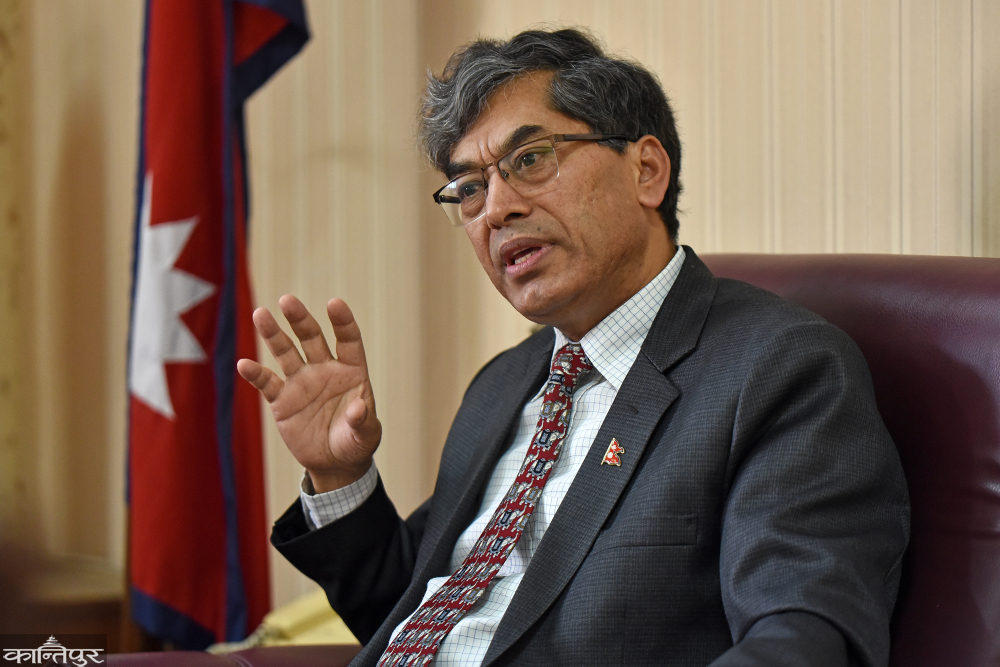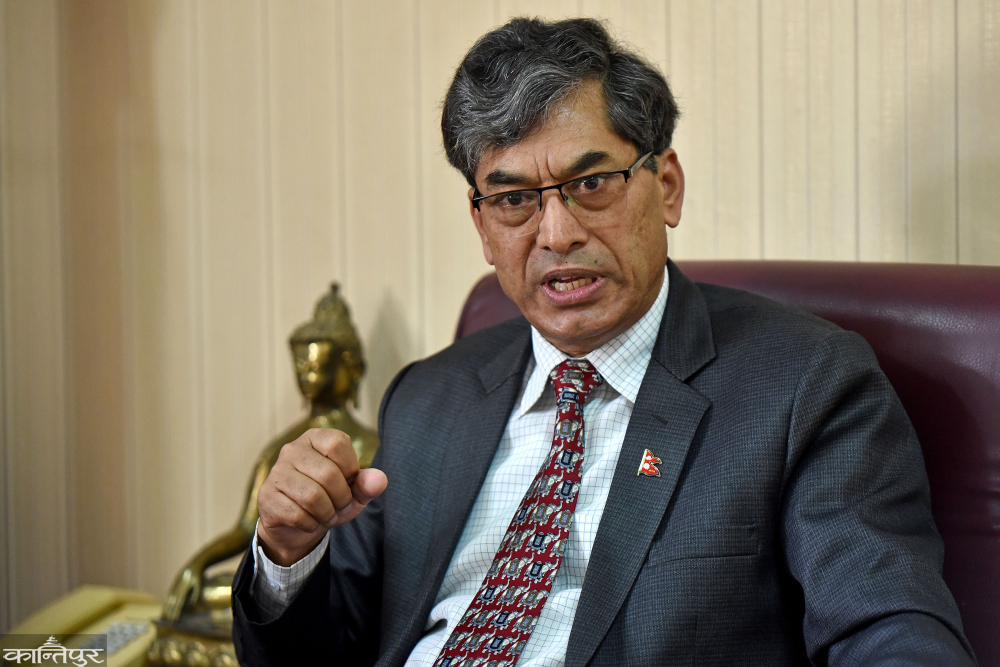'4-5 programs to engage the youth in production and employment are coming in the budget' [Interview]
We use Google Cloud Translation Services. Google requires we provide the following disclaimer relating to use of this service:
This service may contain translations powered by Google. Google disclaims all warranties related to the translations, expressed or implied, including any warranties of accuracy, reliability, and any implied warranties of merchantability, fitness for a particular purpose, and noninfringement.


Most of the social, economic and geographical targets set by the Fifteenth Plan were not met. The National Planning Commission has passed the Sixteenth Five-Year Plan with ambitious goals and submitted it to the Council of Ministers for implementation. The Commission is engaged in preparing the budget for the next financial year by finalizing the plan made for the financial year 2081/82 to 2085/86 and aligning it with it.

!['4-5 programs to engage the youth in production and employment are coming in the budget' [Interview]](https://assets-cdn-api.ekantipur.com/thumb.php?src=https://assets-cdn.ekantipur.com/uploads/source/news/kantipur/2024/money-finance/min-bdr-shrestha-1252024053601-1000x0.jpg&w=1001&h=0)

Coincidentally, the time for approving the sixteenth plan, submitting policies and programs and preparing the budget has come. The prime minister, the finance minister and the vice chairman of the National Planning Commission also belong to the same party. In this background, Krishna Acharya of Kantipur and Raju Chaudhary had a conversation with the vice president of the commission Meen Bahadur Shrestha on the review of past plans, features of the sixteenth plan, implementation program and ceiling of the budget:
The concept paper of the Sixteenth Five Year Plan has been approved. How is this plan different from previous plans?
We started formulating the sixteenth plan from May. After finalizing it from the National Planning Commission, we have sent it to the Council of Ministers for approval on Friday. The plan is printed and implemented before the budget. Sixteenth plan starts from next financial year. The Fifteenth Plan or before that, there was a need to prepare the Aadhaar and make the budget based on it. This time we made a complete document without going to Aadhaar. We had discussions at various levels from the beginning. We had discussions with the Prime Minister, federal ministers to secretaries, state chief ministers, ministers, local heads, administrative officers, experts, etc. We have prepared a plan by taking direct suggestions from more than 3 thousand people. In the past,
s used to occur in very detailed program planning documents. When the ministries made the budget, there was a gap when they brought their own projects instead of the ones in the plan. Now we are thinking of guiding the plan in the form of ministries and agencies in the union as well. We have made indicators so that provinces and localities also work accordingly. Not as detailed as in the past, indicators are its specialty. In the past, a ministerial plan was made for what to do in agriculture and industry, but now there is no such plan. We have to increase production and employment. We have put what agriculture should do to increase productivity and employment, what industry should do, and what to do. The continuation of

policy stability is also noted. The main thrust of this plan is good governance, social justice and prosperity. Earlier there were two types of ideas. Emphasis should be placed on economic growth, and after economic growth, redistribution should be done. On the other hand, it was not economic growth, but distribution should be done first. The current thinking is redistributive economic growth. Without good governance, we cannot achieve social justice or prosperity. We have tried to make structural transformation in every sector. Now there are structural problems in all areas. Not only the problem, but the resources are in the planning of what could not be done as per the possibility. It is very satisfactory to have the identification of social, economic, environmental structures about the economy.
Low production and productivity, rising production costs, weak competitiveness, shrinking of the industrial sector, attractiveness in the trade of imported goods rather than the opening of domestic production industries, low export capacity and increasing trade deficit are increasing problems. How has the Sixteenth Plan addressed these problems? As much as the
has been economic growth, it has not helped production and employment. So we have a structural problem. The main theme of structural transformation is to abolish or redesign existing programs and implement new model programs to increase production and employment. We have taken forward the work of improving the structural system. Some work is in the pipeline, the results of which may be visible in the coming year. When it comes to infrastructure construction, first only roads and buildings were built, it took a lot of investment, it took time, but the quality was not there. When it was done, the returns were very low. Now, it is important to see whether the infrastructure works will create employment and production. The resources are not enough even for the grand event of transformational pride of national pride that has been started before this. Therefore, one group should be completed by prioritization, the second group should be kept alive as the funds are not available now, and some work should be continued. It is also said that the infrastructure of the 20th year that could not be completed will be discarded and a new one will be made. The core of our economy as it is now is linked to production and employment. We have imported billions of rupees instead of
ing products. We have also imported agricultural products. Petroleum production does not occur here. Hydro electricity has also increased in that too. Solar energy will also increase. We import more, export less. It affected all areas from research losses. Unable to deal with it, the revenue is low and the economy is lax. We have lost the youth in a democratic country. We have not been able to bring back the youth who went abroad. Therefore, emphasis should be placed on production and employment. Earlier there were separate programs called production and employment. Manufacturing did not increase employment. Employment does not increase production. That's why we have now advanced new model programs.
There are two points in your statement. One is structural reform and the other is restructuring or canceling some programs. In what area are you going to make structural reforms, cancellations or new beginnings? The
plan itself is not an announcement that this or that program will be cancelled. We are formulating the budget for the first year of the implementation of the Sixteenth Plan, these things have been kept in it. About 90 percent of those placed in the Sixteenth Plan begin. Ministries are aware of what has been put in the plan, and are keeping it in the budget accordingly. It will say that this program will be restructured, this program will be canceled. New things designed to implement the new model will come in the next budget. A program once started is not considered to be cancelled, that is the challenge. There is a plan to restructure it. We will carry out new and high-impact programs. The most visible changes in the next year's budget are 4/5 programs that involve the youth in production and employment. Reduce the number of going abroad and those who have spent 8/10 years abroad can immediately return to work here. The program is designed in such a way that one can apply abroad and work here. If there is production and employment, the youth will return to their country. It is said that remittances came in when they went abroad. However, remittances have not helped much. As much as the remittance comes, half of it is spent on imports.
The reason for saying good governance, social justice and prosperity in the Sixteenth Plan is because of the situation in one external area and the other monsoon situation. If the monsoon is good, the economic growth rate of 4-5 percent is easily achieved. Along with agriculture, when the monsoon is good, the production of hydropower increases. Sixteenth Plan intervention will take our target higher. There is also a risk that we may not be able to do what we want to do, due to one internal reason and the other due to political instability. However, if we proceed smoothly according to the plans made, the goals of the Sixteenth Plan will be fulfilled. After that, some bases have been set that can go into the decade like China, Vietnam, India. The Sixteenth Plan takes it to a new dimension. For example: Production in the energy sector was low a hundred years ago. How much has been added in the last 10 years, 5 years and this year? An additional 200 MW is being added by the end of this June. The next year is also increasing, we are also exporting. It has multiple effects. Similarly, how much impact will the new project Bheri Babai Diversion Project have on irrigation? A new milestone has been added to the Sunkoshi-Marin diversion development. It irrigates and recharges more than 100,000 acres of land not only in hydro. Recharge of the lower belt increases fertility. Therefore, if you can connect the energy in the pipeline to the transmission, you can export it, it will take it to a new dimension.
is another tourism. Before covid, our airport was only one, when it was fully utilized, 1.2 million tourists came. Now there are 3. This means that 3.6 million tourists can be estimated. Calculated from January 2024, it comes at the rate of 16 lakhs. It means that we can make great progress in tourism, get a lot of benefits. Now we have to increase the number of tourists. After that, when they come from abroad, they should bring their goods and not only serve them here, but also make them consume domestic products. Next, a high-quality tourist attraction environment should be created. We upgrade from less developed countries, then quality people, investment will come. Therefore, we have a lot to gain in tourism. After generating 41,000 megawatts from energy, there may be no place to generate. However, there is no limit to tourism. It is to prepare the base for that.

Information technology is another important area. It has been seen that the software will sell up to billions. Now, if the government supports, there will be a lot of development in ICT. The development of ICT and energy opens up industry. Apart from these, large industries can also be operated. When producing cement, it had to be produced from generators, the cost increased. Now it can be produced by electricity. The same is true in ICT. In the past, one had to stand in line all day to pay the electricity bill. Now with one click. As the first intervention of next year's budget, we have kept ICT and data as a signature program. In the sixteenth plan, there is a plan to create an ICT hub. Digital Nepal Framework is a very good program. However, various problems arose during the implementation. There are plans to increase speed, storage, go to 5G. There is also a plan to ensure cyber security. In the first year of the program, about 10 young people will start a firm together, if they start working, they will be given a subsidy for hardware, software and additional tax breaks. Many in ICT have called themselves environment-builders. Government helps in building infrastructure.
The Sixteenth Plan has also prioritized the use of natural resources. The natural resource that we have been using since the beginning is the land. 4 million hectares, about 2.5 million hectares were cultivated. Of the rest, 30 percent is barren, requiring more cultivation. We cannot get rich without using the land. Therefore, we make full use of the land by expanding the development of agriculture. It is a forest that we have not been able to use due to narrowness. Billions worth of wood has rotted, but we have used billions worth of wood and furniture. It's the other way around. To utilize natural resources one is using wood and the other is using forest area. Animal husbandry or herb cultivation can be done to protect the forest. Forests can be leased out in sections. Next, water can be exported. Countries like Qatar have shown interest. Products can be created using rivers, lakes.
Most of the social, economic, and geographical targets set by the Budget and the Fifteenth Plan were not fulfilled. In every plan there is a tendency to set ambitious goals but not take priority to achieve them. Will the implementation of the 100th plan be just one such series?
may be correct up to the thirteenth plan. In the Fourteenth Plan, an economic growth of 7.2 percent was said. 7.4 percent achieved. Based on long experience, we have made the fourteenth plan somewhat realistic. At that time, Pushpa Kamal Dahal Prachanda was the Prime Minister for the second time. After the constitution came, it was said that Madhesh would separate due to the displeasure of Madhesh power and the manipulation of external powers. At that time, the Prachanda government made a peaceful landing. During the making of the Fourteenth Plan, the bandh/strike was stopped due to a political settlement. After that, as soon as load shedding was removed, the production capacity of the industry increased. Increase production, reduce production costs.
It was designed that the Prime Minister himself would inspect the projects of great pride and solve the problems there. It was easy to solve the problem by giving instructions in the field. After the earthquake, we raised external and internal investment. All these led to economic growth. The development and goals of the social sector were already there. Confidence was increased. It was said to make a good basis for economic activities, that has happened. Another important thing is the time to take advantage of the infrastructure. A three-tier structure was implemented in the country when the Fifteenth Plan was made. After the implementation of federalism, the allocated budget would go to the local level. Due to the implementation of federalism, development gets accelerated, on the basis of which the target of high growth was set. There are two reasons for not being successful: At the beginning of the implementation of the Fifteenth Plan, Covid happened. Economic growth slowed to 2.3 percent. It ruined everything. Next, there was the Russia-Ukraine war. The price of petroleum products increased sharply. Construction workers had to stop work. Food prices also increased. As the cost of everything went up it also had an impact. Had the internal scenario of the Fifteenth Plan not been like that, we could have achieved an economic growth of more than 7 percent. However, political instability and our structure have spoiled it. Now the war has started in Israel too. Something happens regionally and internationally. There is also an internal risk.
As you said, whether it is information technology or barren land, hydropower or agricultural work, it is the young people who do it. Our skilled manpower is going abroad for employment after studying. What are you doing for the youth or core workforce living here? The Sixteenth Plan has designed special interventions for
production, employment and youth mobilization. That will come next year. Now, until the budget comes, we will not be able to say exactly that. For example, the land is barren, this is where people work. Now not all households do agriculture. Agriculture is not a poor profession. We have designed it as a profitable industry. By consolidating more than 100 plantations in hilly areas and more than 50 bighas in Terai, more than 10 people can gather together and run companies and cooperatives to produce large quantities. Some investors from Gulf countries have been requesting to provide thousand bigha of land. He has talked about producing for Nepal and taking the excess product. Now this concept could not be developed as it is cultivated in small pieces. Our current farming system is a loss making business. So the farmer would be poor. In order to break it, there is a plan to use it for the production and employment of all, including private or public barren land, forest area, river, lake section.
was called economic-social development in the past. According to the instructions of the Prime Minister, we will now take economic, social and environmental development together. This means that we guarantee all three, including the sale or extraction of river products, forest and river use. We place environmental development and conservation at the center. Now the farmer should not work as a farmer and work in marketing the whole time of the farm. Farmers open their own companies, lease companies and land. They invest a little, the government gives some subsidy and the loan is arranged on a concessional basis. They also have no problem with marketing.
In principle, the National Planning Commission prepares a plan for a certain period. Based on that, policies and programs, budgets, and monetary policies will be made. In Nepal, plans are made well, long-term thinking and goals are set. Based on that, the ministries and agencies of the three governments will make plans and implement the program. But policies and programs are not made according to the five-year plan, budgets are not made according to policies and programs, monetary policies are not made according to the budget, and even the relevant ministries and departments of the government have a tendency to make policies and programs in their own style. Why is this happening? What should be done to prevent that from happening?
This is the aspect that guarantees the sixteenth plan. Earlier there was no coordination between planning, policy and program and budget. Now, for the first time in history, the sixteenth plan, policy and program and budget are being written simultaneously. All the secretaries and ministries involved in this, the main thing to increase production and employment was put in the guidelines. They are included in the policy and program. Keeping that in mind, the budget program has been designed. The backup budget is being allocated to that amount. The gap between goals and technology between past plans and current plans is minimized. Although

plans have been included in the policy budget, not all of them have been implemented. Now we have moved forward in many ways to implement the programs written in the budget. The Monitoring and Evaluation Act, which has been advanced by the Planning Commission for a long time but has not been passed, has been passed. Even though a project was monitored and reported before, no one followed it. Now we have created a special mechanism under the chairmanship of the Prime Minister. Now it goes to implementation. Every 15 days, a meeting of the Major Projects Steering Committee is held, the ex-officio members of which are the Ministers of Finance, Land Reforms, Forests and related projects. The committee discusses the report. If there is a problem regarding budget, staff, forest or roles, it will be implemented immediately. With the Sixteenth Plan, we have created a procedural mechanism to implement the good governance policy and budget.
During the making of the sixteenth plan, no party or expert has become unanimous-all-party. Everyone has a son. The best part is that the scheme has been 100% implemented no matter how many governments have changed since its inception. Even if there are some changes in the policy program, the priority is the development that everyone wants.
According to the sixteenth plan, the program will come in the upcoming budget. The Planning Commission has previously set a budget ceiling of 18 trillion to the government. But the Prime Minister is in the mood to bring a budget of more than 19.5 trillion according to the medium-term expenditure structure. It was also revealed that there was some disagreement with the previous Finance Minister Prakash Sharan Mahat on this matter. Do you maintain the pre-determined mark or give a new ceiling? The extent of
budgets has previously been assessed on the basis of various indicators. The ceiling of the budget was fixed so that a budget of more than 18 billion rupees could not be made. According to the developments in the meantime, 2/3 things can be considered. At that time the revenue was low. The confidence level of the finance minister, the working staff of the finance ministry, was poor. There has been some improvement since then. It is also about how much internal debt to take. The size of the country's gross domestic product (GDP) had not yet arrived. Now it has arrived. According to the ceiling given by the Law and Finance Commission, the ceiling of the budget may have to be increased if there is an increase in revenue and internal debt.
As far as the desire for a bigger budget is concerned, the Prime Minister has a clear opinion on it from the beginning. When the economy is slack, the government will spend to increase consumption. Therefore, he has asked to see if it is possible to bring more than the current ceiling to increase the spending. It is said that by amending the procedures, if there is a situation where the internal debt revenue needs to be increased or decreased, the resource committee can review the limit a week in advance. We are working accordingly. It cannot be said that the budget will increase or decrease. However, there is one provision to review. If there is a further decrease, the resource committee meeting on May 6th or 7th will decide whether to increase or decrease the program in terms of loan, assistance, and revenue.
But there is no situation to increase the size of the budget both in terms of income and spending capacity. In particular, should the size of the budget be increased/decreased based on the ability to spend or in terms of income?
requirements are unlimited. It would be better to make a budget of 20-22 billion now. But resources are limited. Spending and planning within that. The size of the current budget is 17 trillion 51 billion. Even if 90 percent of it was spent, there would have been a radical change. We are determining the expenses for the coming year. Therefore, even if it is 18 billion, we expect to change the spending system. Even if the size of the budget does not increase much, we can make good progress according to our goals in social, economic and environmental terms.
We have developed the economy as three pillars (government, private and cooperative). Now in the sixteenth plan How much of these areas will be your plan?
We have calculated what is the investment situation in different areas, limits, production, income tax. We have also fixed the amount required for the total period of the next sixteenth plan. An investment of 1 trillion 27 billion is required in 5 years. Of that, we have estimated that the government will invest 30 percent, the private sector will invest 67 percent, and cooperatives will invest 3 percent. That means next year the government should invest 5 billion. Even though we made the allocation, we did not spend it. 3 to 3 and a half billion in capital expenditure in the coming year will also be spent at the local level, that's enough. However, it had to be spent. There are also figures that the private sector spends more than the government. The government should also spend more to make the private sector spend more. It would have been better if the ratio was only 20 percent now. Apart from that, in total we do 30 percent, the remaining 70 percent are done by private and cooperatives. Counting private and cooperative together is not inappropriate.
But the co-operative problem is so dire that now it seems that this concept will not advance. In such a situation, on what basis have you planned that the cooperative will still contribute 3 percent to the economy?
Sixteenth plan aims to strengthen the cooperative sector and maintain good governance. We will implement it. Now there are many problems in the cooperative sector. 20 years ago, it came in the budget that a separate institution should be created for cooperative regulation. But the actors did not allow it to be implemented. In every budget and monetary policy, it was said to establish a second level institution, but it did not happen. Now all are approved. Therefore, the government has formed a committee to solve the problem of cooperatives. Cooperative regulation and monitoring organization is being built. It is felt that mistakes should not be made even within the cooperative. People are alert. Let's open a cooperative now, there is no way that money will come. More than all the cooperatives are bad, it seems that there is a problem in cooperatives that are less in number, have more transactions and involve more people.
 प्रकाशित : वैशाख ३०, २०८१ ०९:४८
प्रकाशित : वैशाख ३०, २०८१ ०९:४८

 २१.१२°C काठमाडौं
२१.१२°C काठमाडौं
















